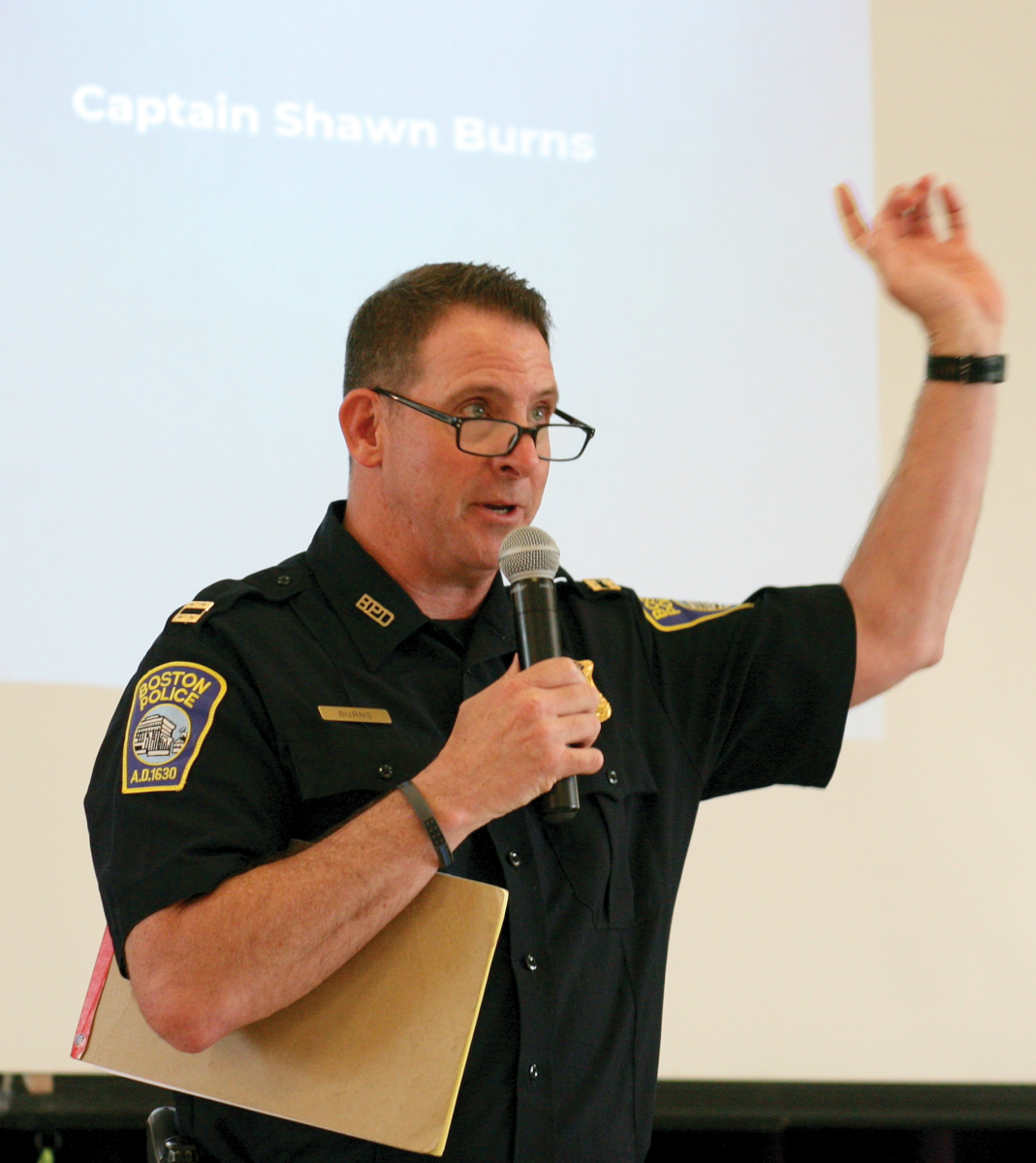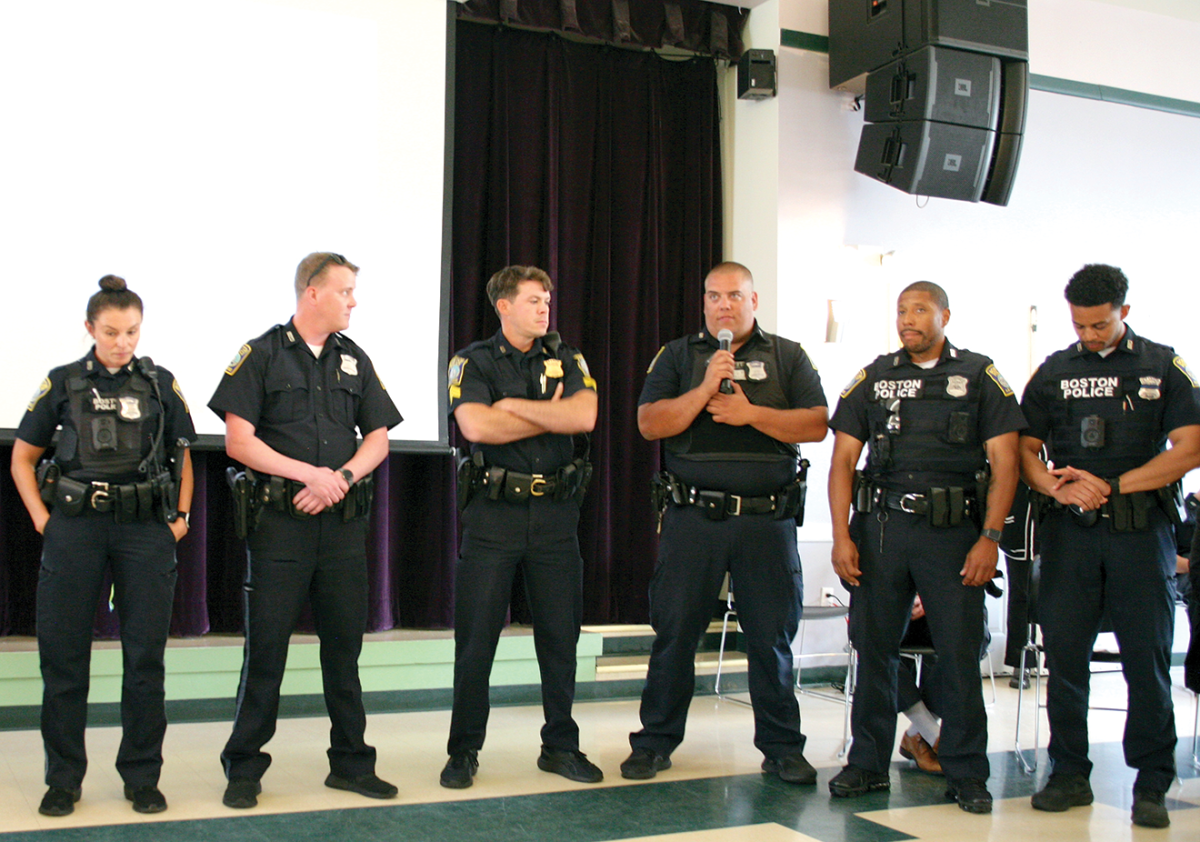June 21, 2023

Commissioner Michael Cox and Supt. James Chin and members of the Fields Corner community at an informational meeting on June 13. Seth Daniel photos

Boston Police Commissioner Michael Cox has launched a series of meetings in neighborhood settings aimed at giving the public a better understanding of the statistics, trends, and strategies at play as police leaders seek to keep the city safe this summer.
Once held behind closed doors at the BPD’s headquarters at Schroeder Plaza, there have been two such local meetings held in the last week, one of them in Fields Corner last Tuesday (June 13).
“We are trying to do something a little different than what we’ve done in the past,” Cox told a group of about 100 people who had gathered at the VietAID community center on Charles Street. “We’ve been coming out to community meetings for many, many years, but I don’t think people understand everything we do to keep you safe and to work with you.”
Cox was joined at the meeting by Area C-11 Captain Shawn Burns and other senior BPD officers.

C-11 Capt. Shawn Burns.

Patrol officers from C-11 introduced themselves one by one, a presentation that was well received by community members in attendance who were told that most of the district’s officers live in, or grew up in, Dorchester.
The commissioner explained that police leadership routinely work with the Boston Regional Intelligence Center (BRIC) to learn of statistics, intelligence, and trends “to put the resources in the right places to keep everyone safe.”
He said the new idea is to integrate “CompStat [a multifaceted and interactive approach to crime control and quality of life improvement] “with what you find important and what you think are the needs in your community.”
Burns noted that the BPD has looked at numbers and trends for many years inside the police station and used that data to make staffing decisions. Now, they would like to accentuate the numbers with community experiences.
“This is something we do every day in BPD when we work with stats and look for trends to utilize our resources in the best way possible, but we want to know what’s important to the community when we make those decisions,” he said.
BRIC Dep. Supt. Gerald Cahill, and Deputy Director Ryan Walsh, explained that his agency emerged in the aftermath of 9/11 to address international terrorism at the ground level. Now, BRIC also focuses heavily on crime stats, real-time crime assessments, and domestic terrorism.
They detailed stats and strategies being used in the C-11 District and the Fields Corner sub-district to combat serious crime, and quality of life crimes such as vandalism, fireworks, motor vehicle crashes, and loud parties.
In those stats, there has been a trend toward street robberies and larcenies being on the increase, with a small increase in shootings and homicides.
For quality-of-life crimes, there has been an upswing in calls for public use of intravenous drugs, and of publicly intoxicated persons. Loud party calls have gone down, as have fireworks complaints, aside from one address on Ditson Street that is an ongoing problem.
“For intoxicated persons, Fields Corner and Hancock Street are hot spots,” said Walsh. “That is driving a quality-of-life concern in Fields Corner and other parts of Dorchester Avenue in C-11.”
Other issues identified by Walsh and the C-11 Community Services officers were illegal scooter/ATV usage, barbershop health code violations, and code enforcement on problem properties.
A major part of last week’s meeting was time spent introducing command staff and individual beat officers from C-11. At one point, patrol officers introduced themselves to the public,earning applause. It is noteworthy that of the 12 officers introduced, a large majority live in Dorchester or grew up in the community.
In fact, Jamie Miller, the deputy supt. of Investigative Services, told the crowd that his great-grandfather bought a house in Dorchester that has served as the family home for his grandfather, his father, and himself. “That’s the same house I am raising my kids in,” he said.
Virtually every branch of C-11’s operations, and many police headquarters operations, were introduced and talked about in great depth – including C-11 detectives showing community members how they used private video recently to solve a purse snatching on Geneva Avenue.
Neighbors were clearly appreciative of the presentation, with some in the audience from Fields Corner and Four Corners saying they would like additional meetings like this – particularly to meet individual officers and leaders.
Issues identified by the public in a short Q&A included more focus on quality-of-life crimes, a need to add more Vietnamese-speaking officers, reintroducing police into the schools to help young people, patrols focused on Faulkner Street in Fields Corner, and informing/updating the public when there are serial criminals on active crime sprees.
Cox said the BPD would be willing to bring in the CompStat data on a monthly, quarterly, or semi-annual basis. “We need your support and we’re ready to adjust and change and do what we need to do,” he told the audience. “You will be the driver of this.”
He added: “A lot of people have been turned off to policing just due to the narrative out there about us around the country. It didn’t happen overnight and won’t change overnight, but it will change when we tell the story of the good people that do this job.”
The third community presentation is scheduled to take place in Jamaica Plain’s District E-13, with others to come around the city over the summer months.


